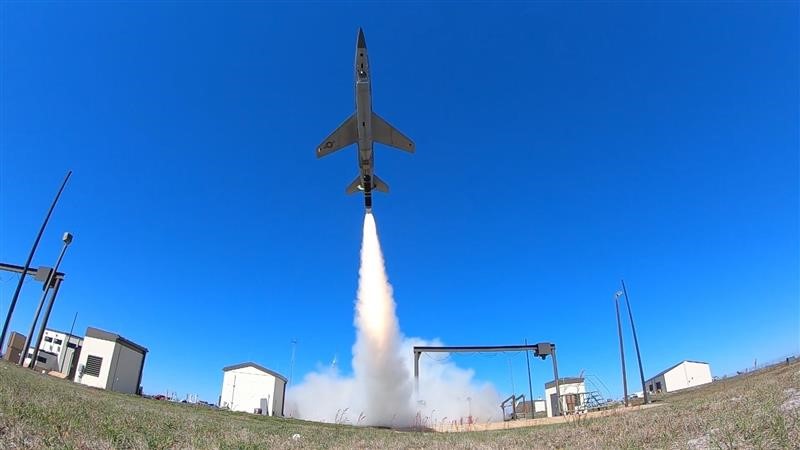Skyborg, an autonomy suite of hardware and software meant to develop the Air Force’s use of manned/unmanned aircraft teaming, made its first flight aboard a Kratos UTAP-22 Mako air vehicle on April 29, the Air Force Life Cycle Management Center announced.
The 130-minute test at Tyndall Air Force Base, Florida, represented the first Milestone of the Autonomous Attritable Aircraft Experimentation (AAAx) campaign, AFLCMC said. Skyborg is one of three USAF “Vanguard” programs announced in 2019 as key experiments to rapidly field advanced technologies. The Mako is a derivative of the BQM-167A aerial target. “Attritable” refers to an aircraft that can be used multiple times but is inexpensive enough that its loss in combat would be operationally bearable.
The aircraft performed a “series of foundational behaviors necessary to characterize safe system operation” during the flight, AFLCMC said. The aircraft responded to navigational commands, stayed within set “geo-fences,” stuck to its flight envelope, and “demonstrated coordinated maneuvering.” Both airborne and ground control stations monitored its progress.
The 96th Test Wing carried out the mission at Tyndall.
The flight represents the “first step in a marathon of progressive growth for Skyborg technology,” said Brig. Gen. Dale R. White, program executive officer for fighters and advanced aircraft. “These initial flights kick off the experimentation campaign that will continue to mature” Skyborg, also known as the autonomy core system, or ACS, for so-called “loyal wingmen” unmanned escorts. White described ACS as the “‘brain’ of the Skyborg system.”
White shares leadership of the program with Air Force Research Laboratory chief Brig. Gen. Heather L. Pringle, who serves as the Skyborg technology executive officer. Pringle called the experimental campaign a way to get technology into the hands of operators quickly, giving them a “suite of full mission autonomy on a relevant timeline.”
The next series of events in the campaign will demonstrate manned/unmanned teaming using a crewed aircraft and “multiple ACS-controlled unmanned aircraft,” AFLCMC center said.
The Skyborg effort seeks to integrate full-mission autonomy with “low-cost, attritable” unmanned air vehicles, AFLCMC said. “Skyborg will provide the foundation on which the Air Force can build an airborne, autonomous ‘best of breed’ system of systems” that will adapt and orient to the battlespace and make decisions “at machine speed for a wide variety of complex mission sets,” the center said.
Autonomous UAV technology is advancing on a number of fronts. In August 2020, an artificial intelligence program defeated a human pilot in a series of 50 simulated dogfights, although the AI was provided with information about its opponent’s energy state that a true adversary would not have.
Steve Fendley, president of Kratos Unmanned Systems Division, said the Mako has been involved in a number of technology demonstrations and exercises since it was introduced in 2015 and has served as “a key tactical attritable UAS” and a technology “incubator” for the company’s XQ-58 Valkyrie.
Kratos describes the Mako as having “fighter-like” performance, with an operational ceiling of 50,000 feet and top speed greater than 0.9 Mach. It also says the vehicle can present “flexible vehicle signatures.” The aircraft is launched with a rocket assist from a ground vehicle or pad, allowing it to be operated from locations without a runway, and is recovered by parachute. It has an internal payload volume of 8.5 cubic feet.

